Regional selection of insecticides and fungal biopesticides to control aphids and thrips and improve the forage quality of alfalfa crops
PAN Fan ,GAO Li-jie ,ZHU Kai-hui ,DU Gui-lin ,ZHU Meng-meng ,ZHAO Li,GAO Yu-linTU Xiong-bingZHANG Ze-hua
1 State Key Laboratory for Biology of Plant Diseases and Insect Pests,Institute of Plant Protection,Chinese Academy of Agricultural Sciences,Beijing 100193,P.R.China
2 College of Animal Science and Technology,Hebei Agricultural University,Baoding 071001,P.R.China
3 National Animal and Husbandry Service,Beijing 100125,P.R.China
4 Institute of Plant Protection,Ningxia Academy of Agricultural and Forestry Sciences,Yinchuan 750002,P.R.China
5 College of Agriculture,Xinjiang Agricultural University,Urumqi 830052,P.R.China
Abstract The efficacies of biological and conventional chemical insecticides against two major insect pests of alfalfa (aphids and thrips) were compared in three sites across China’s alfalfa belt.In addition,the persistence of the residues of chemical insecticides in alfalfa and their influence on the quality of alfalfa hay were examined.Efficacy varied among the different biological and chemical insecticides.The chemical insecticides were significantly more effective than biopesticides in a short time-frame.The efficacy period of biopesticides was significantly longer than that of chemical insecticides,and the corrected mortality rate of aphids in all regions was above 50% at 14 days after application.The analysis of pesticide residues showed that the residual doses of all the pesticides were within the allowed ranges after the safe period.The acid detergent fiber and neutral detergent fiber contents in alfalfa hay were higher and the protein content was lower in chemical insecticide treatments than in biopesticide treatments in Hebei.The relative feeding value of alfalfa hay treated with Metarhizium anisopliae IPP330189 was the highest among the treatments.Compared with chemical insecticides,the yield of alfalfa hay was higher in the biopesticides treatments.Biopesticides show a stronger control effect on insect populations and also a better improvement in the quality of alfalfa hay than chemical insecticides.This study provides a basis for exploring and developing a comprehensive control regime for alfalfa insect pests in the different alfalfa-growing regions in China,and for reducing chemical insecticide usage and improving forage quality.
Keywords: insect pest control,pollution free control,pesticide residue,aphids,thrips
1.lntroduction
Alfalfa (Medicago sativaL.) is the forage crop with the longest planting history,the widest distribution,the largest cultivated area,the highest production level and the highest economic value in the world (Zhanget al.2000;Yang 2012).It also has high nutritional,medicinal and edible values.Alfalfa is not only rich in protein,minerals,vitamins and other important nutrients,but it also contains essential amino acids,trace elements and unknown growth factors needed by animals.It is about 2.5 times higher in digestible protein,6 times higher in minerals,and 2 times higher in digestible nutrients (Liu 2006).Alfalfa plays a very important role as a major feed material in animal production(McGinnet al.2004;Bulanget al.2006).For example,the addition of 5% alfalfa meal to the feed of poultry layers can significantly improve the yolk pigment ratio (Heet al.2001).The addition of an appropriate proportion of alfalfa products to a growing and fattening pig diet can also increase lean carcass yield (Li Y Pet al.2015).Furthermore,the daily milk output and milk fat rate can be improved by feeding silage alfalfa to dairy cattle (Clark and Armentano 1997;Plaizieret al.2004;Kammeset al.2008).
In China,the planting area of alfalfa has been expanding with the ongoing reforms in the country’s crop industry,and with that expansion the problem of pest control has become more prominent.The most damaging insect pests to alfalfa are aphids and thrips.For example,in Ningxia Hui Autonomous Region,the rate of damage caused by thrips in alfalfa fields is as high as 100%,which results in a 5% yield loss in low incidences and 100% in high incidences (Zhanget al.2005).The incidence of damage to alfalfa caused by aphids is about 70%,resulting in a yield loss between 30–40% (Temueret al.2005).Chemical control is still the most important method in alfalfa planting management.However,the use of chemical insecticides pollutes the environment directly,but also causes the accumulation of pesticide residues in animal products which can enter the food chain,posing a threat to human and animal health.A survey of silage in Inner Mongolia found 59.1% contaminated with organophosphate residues (Wang 2011).Also,cows which fed on herbage contaminated with trifluralin died of poisoning (Ye and Ku 2014).In addition,long-term single use can increase resistance in insect pests,resulting in more difficult pest control.In 2005,the resistance level of onion thrips to diazinon in Canada was 165.8 times higher than during the first use.From 2007 to 2011,the resistance levels of onion thrips to spinosad and methylamine in Israel were the highest,reaching 5 000 times and 21 000 times the levels in the first use,respectively (Allenet al.2010).
As a biological control agent,fungal biopesticides utilize the interactions between biological species to control insect pests.It is relatively host-specific and safe for the environment.At present,biopesticides are used globally for the control of all kinds of agricultural insect pests.For instance,they have been used for coffee pest control in Latin America and potato pest control in Europe(Wraight and Ramos 2005),as well as for the control of insect pests of grass,bananas and other crops in South America (Cruzet al.2006;Lebedevet al.2013).
The use of alfalfa as a forage crop to feed the animals that supply products safe for human consumption (e.g.,milk and meat) requires that growers understand the fate of pesticide residues used to control pests over time.Therefore,the reduction of pesticide residues and pollution at the source is an important measure to ensure the safety of alfalfa,animal production and agricultural products.This research was conducted in three regions within the alfalfa-growing belt in northern China,and the goal was to evaluate the control effects of chemical and biological pesticides conventionally used in each region on thrips and aphid populations.Additionally,the persistence dynamics of the different pesticide residues and their potential influence on the quality of alfalfa hay were also analyzed.The results provide information on the modes of control of aphids and thrips using selected biopesticides and insecticides for each alfalfa-growing region.They also provide a scientific and reasonable theoretical basis for the safe production of alfalfa.
2.Materials and methods
2.1.Survey sites
The survey was conducted at sites selected in three regions.The first site was located in the Risheng Modern Agriculture Park,North Zhangbai Village,Hebei Province,China (38°18′N,116°21′E).The climate of this region is a temperate continental monsoon,with an average annual precipitation of about 560 mm,an average temperature of 12.3°C,a frost-free period of about 189 days,and an annual sunshine duration of 2 863.3 h.The main insect pests recorded on alfalfa in this region are aphids and thrips (Tuet al.2016,2018),which occur from early May to late September.The second experimental area was located at Huifeng Grass Industry Company Base,Xuhe Village,Ningxia (36°9′N,106°14′E).This region is found in the semi-arid zone of the inland warm temperate zone,with an average temperature of 6.8°C,a frost-free period of 120–140 d,and an annual sunshine duration of 2 250–2 700 h.Likewise,the main insect pests recorded on alfalfa in this region are aphids and thrips and their occurrence is from mid-April to late September (Ma 2004).The third experimental area was located in Hutubi Forage Center (44°14′N,86°55′E),Changji Hui Autonomous Prefecture,Xinjiang Uygur Autonomous Region,China.This area is found in the temperate continental arid and it has a semi-arid climate.The annual precipitation is 167 mm.The average temperature in the plain area is 6 or 7°C,the average frost-free period is 180 d,and the annual sunshine duration is 2 700 h.Likewise,the main insect pests recorded on alfalfa in this region are aphids and thrips,which occur from mid-May to late September(Zhaoet al.2004).
2.2.Planting varieties and field test design
Different chemical insecticides and fungal biopesticides were used in the different regions (Table 1).An unsprayed plot served as the control in each region.Each treatment plot covered an area of about 0.7 ha,with a buffer strip of approximately 2 m between plots.Each treatment was repeated 3 times.
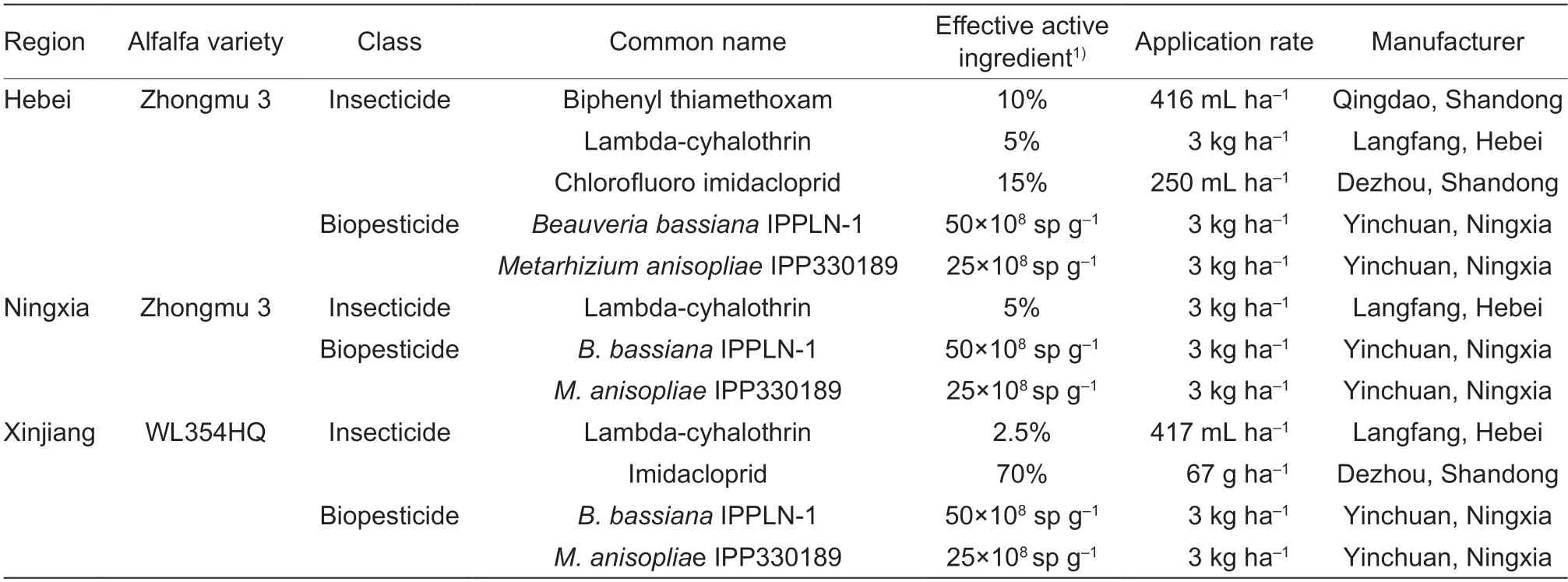
Table 1 Types and dosages of insecticides in the three different regions in China
2.3.Sampling for aphids and thrips
At all sites,aphid and thrips populations were surveyed,before (1 day) and after (1,4,7,14 and 21 days)spraying.The investigation method was the five-point sampling method.Five points were randomly selected in each plot,20 branches were randomly selected from each point,and the species and quantity of aphids from each branch were counted.For thrips,five points were selected in each plot,20 branches were randomly selected from each point,and the thrips were patted onto wet white paper,the white paper was quickly folded in placed in a plastic sealed bag containing a cotton plug soaked in ethyl acetate,and the species and quantity of aphids from each branch were counted.There was no sampling on rainy days.The effectiveness of various agents was evaluated on the basis of adjusted mortality,and the adjusted mortality was calculated.
2.4.Assessing alfalfa quality and yield
Alfalfa samples were taken before cutting (3 days).Using the five-point sampling method,five points were randomly selected in each plot,and 10 stems from 10 plants were randomly selected from each point.After mixing,the samples were placed into plastic ziplocked bag and stored at–20°C prior to analysis.The changes of acid detergent fiber,neutral detergent fiber,protein and relative feeding value of alfalfa were detected by the near infrared detection method.
To determine dry matter (DM) yields (kg DM ha–1),five 20 cm×30 cm quadrats were randomly selected from each plot,cutting 2–3 cm above the ground.The fresh alfalfa was brought back to the laboratory,dried at 105°C for 30 min and at 80°C until constant weight,and the hay yield was determined.
2.5.Determination of chemical insecticide residues
An Agilent system was used for the liquid quality detection of thiamethoxam and imidacloprid residues.Before detection,a 5-g homogenized alfalfa sample was accurately weighed and placed in a 50-mL plug centrifuge tube,5 mL ultra-pure water and 10 mL acetonitrile were added after uniform edging,and extracted after shaking for 10 min.Then,2 g NaCl and 4 g anhydrous magnesium sulfate were added before oscillation for 5 min,centrifugation for 5 min at 5 000 r min–1.A 1.5-mL aliquot of supernatant was taken and placed in a 2-mL centrifuge tube containing 20 mg GCB,30 mg C18and 150 mg anhydrous MgSO4.The supernatant was vortexed for 1 min and centrifuged for 5 min at 5 000 r min–1.The supernatant was absorbed by a syringe and transferred to a 0.22-μm filter membrane in a sample vial for testing.
Before detection,5 g homogenized alfalfa was accurately weighed and placed in a 50-mL plug centrifuge tube,5 mL ultra-pure water and 10 mL acetonitrile were added after vortexing to uniformity,and extracted after shaking for 10 min at 5 000 r min–1.Then,2 g NaCl and 4 g anhydrous magnesium sulfate were added,followed by oscillation for 5 min and centrifugation for 5 min at 5 000 r min–1.A 1.5-mL aliquot of supernatant was taken and placed in a 2 mL centrifuge tube containing 20 mg GCB,30 mg C18and 150 mg anhydrous MgSO4.After 1 min of vortexing,the tube was centrifuged for 5 min at 5 000 r min–1.A 1-mL aliquot of supernatant was absorbed with a pipette gun into the centrifuge tube,blown down with nitrogen,and 1 mL of n-hexane was added to dissolve it.The sample was absorbed with a syringe and passed through a 0.22-μm filter membrane into a vial,prior to testing.
2.6.Statistical analysis
The differences between treatments were compared either by Student’st-test or by one-way analysis of variance (ANOVA) followed by a Tukey’s test for multiple comparisons.We analyzed data using the GraphPad Prism 8.0.1,considered differences significant atP<0.05 and report the values as mean±SE.
3.Results
3.1.Effects of different insecticides on aphid control in the three different regions
All the insecticides tested effectively controlled the aphid populations on alfalfa in all regions.The chemical insecticides were better than the biopesticides in terms of early control effects,but the duration of control provided by the biopesticides was better than that of the chemical insecticides.In Hebei,the effects were better after the application of chemical insecticides on the 1st and 4th days,and the adjusted death rate was 77.3–88.7% (Fig.1).The survival rates of insect populations on the first and fourth days after the application of chemical insecticides were significantly lower than the rates after the application of biological pesticides and the control (P<0.05).Seven days after aphids were treated with neonicotinoids,their survival rates were significantly lower than after treatment with the other pesticides (P<0.05).Biphenyl thiamethoxam had the strongest effect on aphid mortality,with an adjusted death rate of 59.3%.The effects of biological pesticides after 14 days were the strongest against aphids,and were significantly higher than those of the chemical insecticides.In Ningxia,the survival rate of aphids in the plot sprayed withMetarhizium anisopliaeIPP330189 was significantly lower than the rates under other the treatments four days after application (P<0.05).However,at 14 days after application,the survival rate was significantly higher than under the other treatments(P<0.05).The effect of biopesticides on aphid mortality in Xinjiang provided the best control,with mortality of more than 50.0% at 14 days after fungal application.
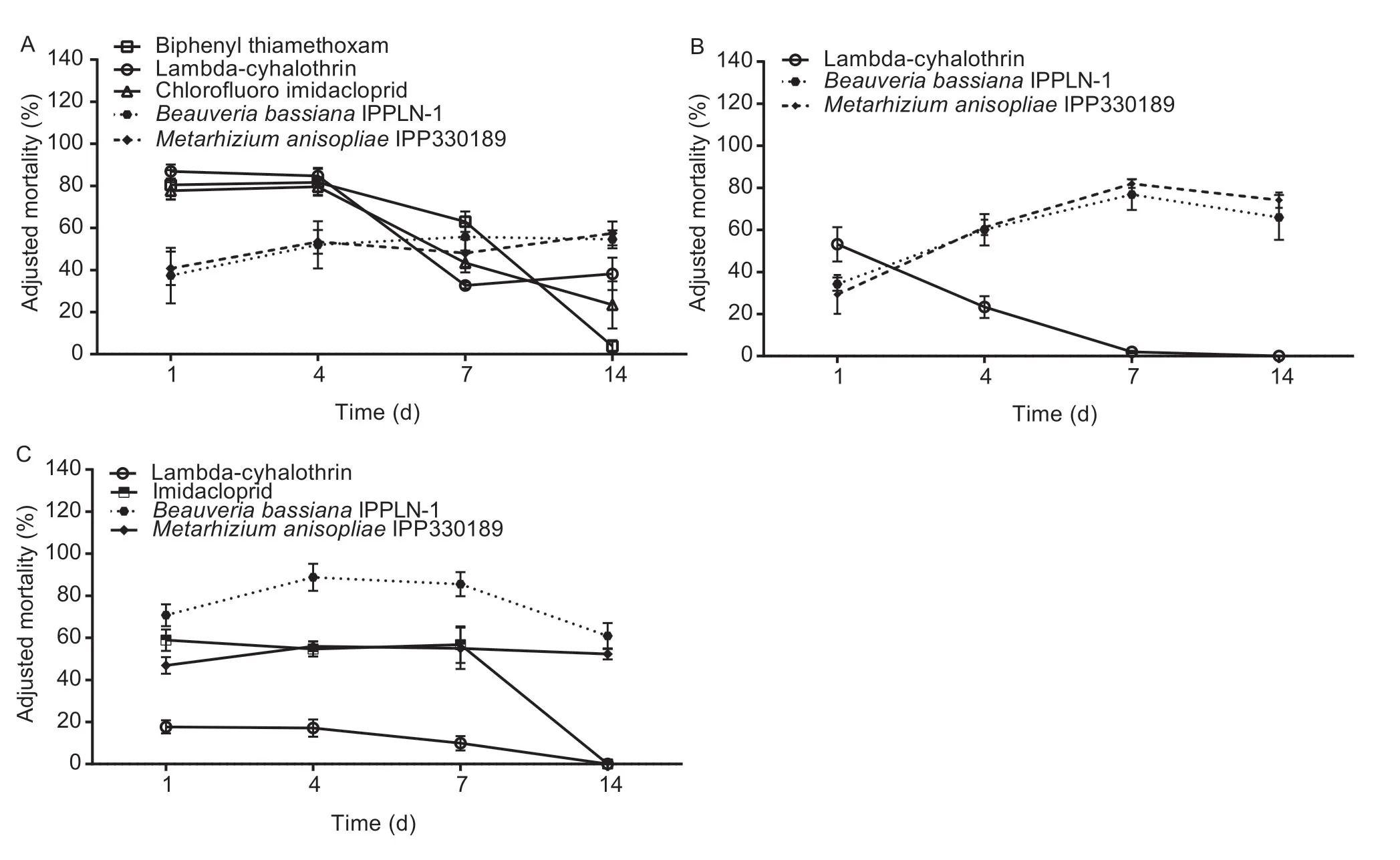
Fig.1 Effects of selected insecticides and biopesticides on adjusted mortality of aphids measured over a 2-week period under field conditions in Hebei (A),Ningxia (B),and Xinjiang(C),China.Data are mean±SE (n=3).
3.2.Effects of different pesticides on thrips in the three different regions
Chemical insecticides had a stronger control effect on thrips populations than biopesticides in the initial stage of prevention and control,but their long-term effects were weaker than those of biopesticides.The control effects of the different pesticides on thrips in Hebei Province are shown in Fig.2-A.The survival rates of thrips at 1 and 4 days after pesticide application were significantly lower than in the control plots (P<0.05).The effect of chemical insecticides on thrip mortality was significantly stronger than that of biopesticides (P<0.05).The adjusted mortality rates (65.2%) for thrip populations in plots treated withBeauveria bassianaIPPLN-1 andM.anisopliaeIPP330189 were the highest of all treatments at 14 days after the biological pesticide application.The survival rates of thrips in plots treated with biological pesticides were significantly lower than those of the other treatments (P<0.05),and the insecticidal effect was significantly higher than that of other treatments (P<0.05).In Ningxia,the insecticidal effects of biopesticides were significantly stronger than those of the chemical insecticides at 7 days after application,and the efficacy of the biopesticides lasted for 14 days (Fig.2-B).In the first few days after pesticide application in plots in Xinjiang,the effects of chemical insecticides were significantly stronger than those of the biopesticides;cypermethrin was the most effective at reducing thrip numbers after the 1st day of applying the insecticide.The adjusted mortality rate reached 90.0% (Fig.2-C).After 5–7 days of the cypermethrin treatment,the survival rate of thrips in the treatment area was significantly lower than that in the control area (P<0.05).The treatment with imidacloprid showed the strongest effect at 14 days after treatment and the adjusted mortality rate was 65.5%.We suspect that thrips may have migrated to other host plants such as nearby thistle populations.
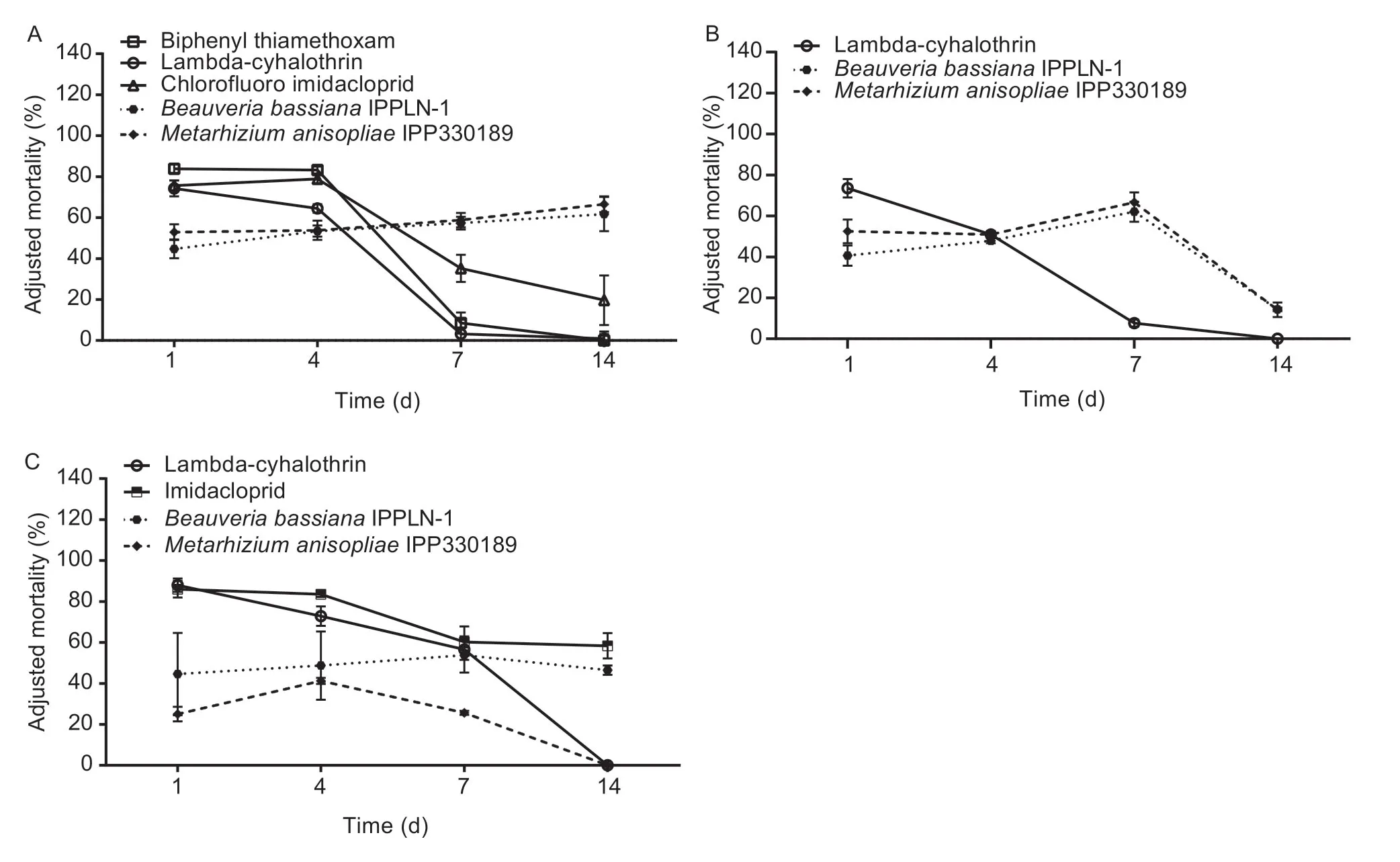
Fig.2 Effects of selected insecticides and biopesticides on adjusted mortality of thrips measured over a 2-week period under field conditions in Hebei (A),Ningxia (B),and Xinjiang(C),China.Data are mean±SE (n=3).
3.3.Effects of different chemical residues on quality and yield of alfalfa in different regions
The acid detergent fiber (ADF) of alfalfa treated with biphenyl thiamethoxam was the highest in the Hebei,and it was significantly higher than the ADF of other treatments (P<0.05) (Fig.3-A).The neutral detergent fiber (NDF) in the plants treated with neonicotinoids(biphenyl thiamethoxam and chlorofluoro imidacloprid)was significantly higher than the NDF the other treatments(P<0.05).There were no significant differences between the other treatments.The average protein contents (PC)of the different treatments were between 19.6 and 23.3%.The PC in the neonicotinoids treatment was significantly lower than those in the other treatments (P<0.05).The relative feed value (RFV) of plants treated with nicotine was significantly lower than the RFV of other treatments(P<0.05).There were no significant differences between the other treatments (P>0.05),where the average values were between 126.6–135.7.The RFV of the alfalfa treated withM. anisopliaeIPP330189 was the highest.There were no significant differences in ADF,NDF,PC and RFV for alfalfa samples between treatments in Ningxia and Xinjiang(Fig.3-B and C).There were no significant differences in hay yield of alfalfa treated with the various agents in Xinjiang (P>0.05).Hay yields of alfalfa treated with fungi in Hebei and Ningxia were significantly higher than those of their other respective treatments (P<0.05) (Table 2).
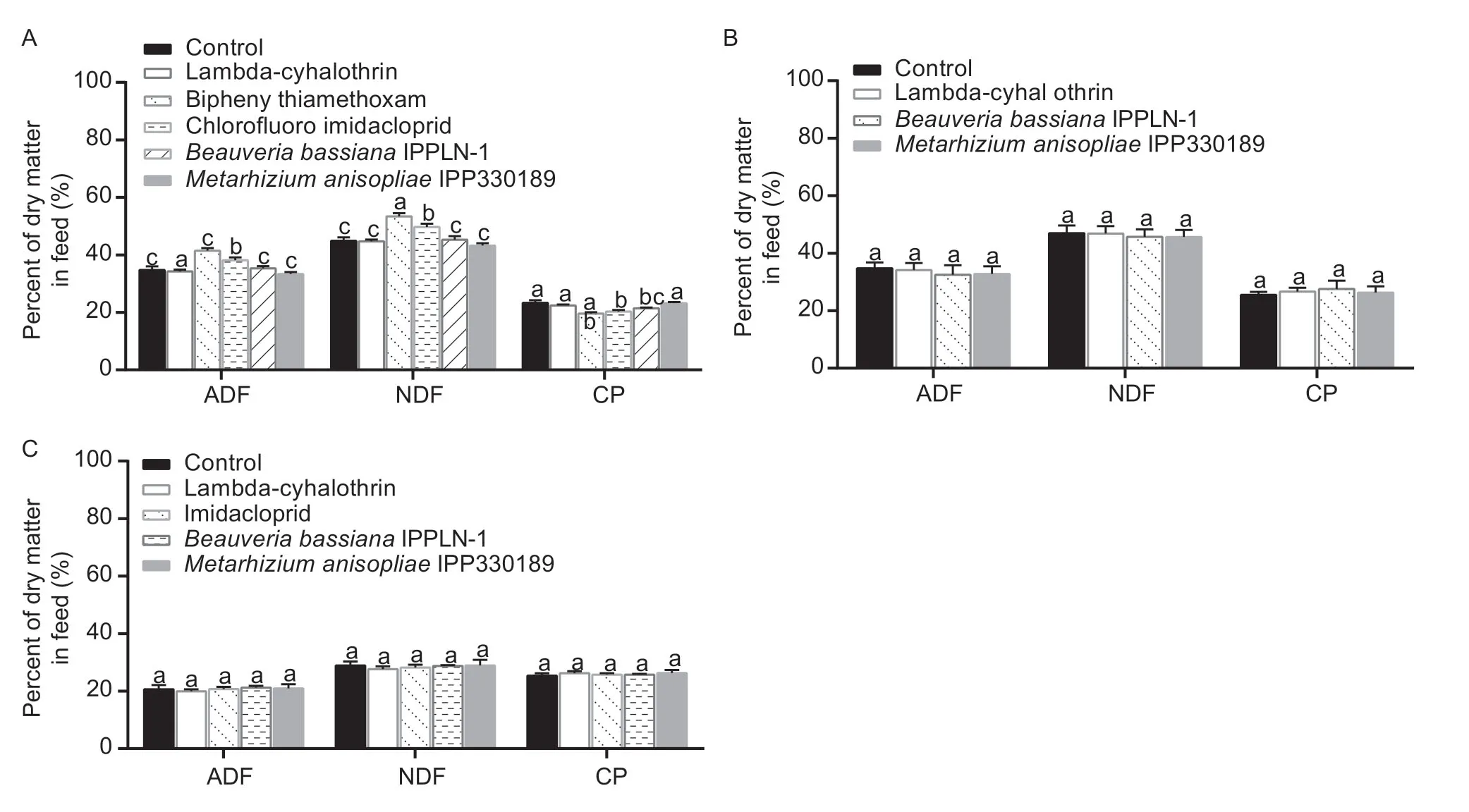
Fig.3 Effects of selected insecticides and biopesticides on the quality of alfalfa hay measured 2 weeks after treatment under field conditions in Hebei (A),Ningxia (B),and Xinjiang(C),China.ADF,acid detergent fiber;NDF,neutral detergent fiber;CP,crude protein.Data are mean±SE (n=5).Different letters mean significant difference (P<0.05).

Table 2 Alfalfa dry matter yields following treatment with selected insecticides and biopesticides in the three different regions in China
3.4.Degradation dynamics of residues of different agents
The degradation dynamics of all the applications used in this study showed a similar trend of an initial rapid decline,then a slow decline until the rates flattened (Fig.4).The degradation rates of cypermethrin were 61.8,73.6,and 80.8%,respectively,at 4,7 and 14 days after spraying.The degradation rate of cypermethrin was 56.2,68.8,and 79.0%,respectively,at 4,7 and 14 days after spraying.The degradation rates of imidacloprid were 93.2,98.6 and 99.0%,respectively,for the same application days.The degradation rates of bifenthrin at 4,7 and 14 days after spraying were 54.7,75.0 and 79.1%,respectively,and the degradation rates of thiamethoxam were 63.7,85.9,and 97.8%,respectively.The degradation rates of imidacloprid were 75.9,98.1,and 99.6%,respectively,at 4,7 and 14 days after spraying.
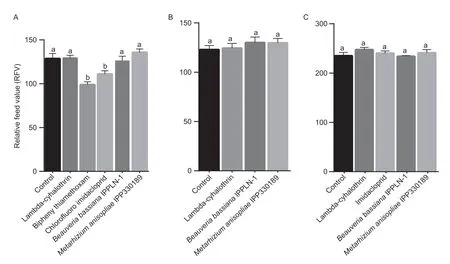
Fig.4 Effects of selected insecticides and biopesticides on the relative feed value (RFV) of alfalfa hay measured 2 weeks after treatment under field conditions in Hebei (A),Ningxia (B),and Xinjiang (C),China.Data are mean±SE (n=5).
4.Discussion
4.1.Effects of different chemicals on insect pests in three different regions of northern China
Field experiments in all three regions (Hebei,Ningxia and Xinjiang),showed that all the insecticides had different levels of control for aphids and thrips in a relatively short time (1–4 days).The effects of chemical insecticides were short-lived,while the effects of the biopesticides were initially weaker but they were longer-lived and eventually outperformed the chemical insecticides.In Hebei,biphenyl thiamethoxam and high efficacious cypermethrin had the best control effects in the early stages after pesticide application.The control effects ofB. bassianaIPPLN-1 andM.anisopliaeIPP330189 also played a major role later.At the same time,the incidence of myxomycetes increased significantly in the later parts of the sampling period.The biopesticides performed well in controlling the incidences of myxomycetes.In Ningxia,cypermethrin had a good control effect in the early stage,andM. anisopliaeIPP330189 had a good control effect in the later stages of our study.The control effects of imidacloprid andB.bassianaIPPLN-1 were better in Xinjiang than the other pesticides.
Studies have shown that a combined application of insecticides and biopesticides can improve the prevention and control of pest damage in crops (Zenget al.2009;Wanget al.2015).These findings together with the results of our study suggest that pest managers should carefully consider the selection and rotation of various pesticides when developing pest prevention and control strategies.This would ensure that there is a diversity of pesticide types and dosage forms to account for their different temporal efficacies.Such an approach would help to prevent the development of insect resistance to pesticides due to the repeated and prolonged applications of just one pesticide (Zhai 2001).
4.2.Effects of different pesticide treatments on alfalfa quality in the different regions
Forage is very important for maintaining milk production,improving rumen microbial synthesis efficiency and the rumen environment.It is an indispensable part of the diets of ruminants and other herbivores.Therefore,its quality affects the production performance and health of animals (Liet al.2014).As a high yielding forage crop,alfalfa is widely used for its high feed value.The important indexes used to measure the nutritional value of alfalfa include ADF,NDF,crude protein (CP) and RFV.The NDF is highly correlated with diet fiber content and organic material.Adjustments of the NDF content in feeds can improve ruminant feed intake and nutrient utilization rates in a cow’s digestion process (Wang H Ret al.2017),and also improve rumen health.This would in turn improve ruminant production performance(Parket al.2014;Wang C Let al.2017).Protein is an essential nutrient for ruminants.Diets with different protein levels change rumen fermentation parameters.Supplementing a crude diet with proteins is conducive to the growth of microorganisms in the rumen,which promotes ruminant fiber digestion (Fanet al.2017).The RFV is similar to the roughage quality evaluation index that is widely used in the United States and is being adopted by many countries.According to the alfalfa hay quality grading standards issued by the China Animal Husbandry Association,the lower the ADF and NDF in alfalfa hay,the higher the CP content and RFV,and consequently,the higher the alfalfa hay quality grade.In this study,there were no significant differences in ADF,NDF,CP or RFV in alfalfa hay treated with the different pesticides in two of the regions (Xinjiang and Ningxia),and there were significant differences only in Hebei.However,there were differences between regions.The ADF and NDF in each treatment in Xinjiang were significantly lower than in Ningxia and Hebei.Also,the RFV was significantly higher than those in Ningxia and Hebei,most likely due to the use of different alfalfa varieties.A number of studies have shown that different alfalfa varieties have significant differences in quality(Wanget al.2010;Liet al.2020;Yuet al.2020).In addition,environmental factors,such as temperature and humidity,as well as management style,can also affect the quality of alfalfa.
4.3.Effects of pesticide residues
At present,China has not yet established efficient maximum residue limits for each the four types of agents used in this study (Biphenyl thiamethoxam,Lambdacyhalothrin,Chlorofluoro imidacloprid,and Imidacloprid)on alfalfa.TheNational Food Safety Standardlists the maximum residue limits of the pesticides chlorine fluorine with ester,imidacloprid,bifenthrin ester,and thiamethoxam oxazine on fruits and vegetables as 0.01 to 0.5 mg kg–1,0.5 to 1 mg kg–1,0.05 to 4 mg kg–1,and 0.2 to 0.5 mg kg–1,respectively.For alfalfa,the safety period of these pesticides was 14 days.The residual amounts were 251.5 μg L–1after 14 days in Hebei and 125.9 μg L–1in Xinjiang.The withholding period for imidacloprid was seven days,and its residual amounts were 6.9 μg L–1in Hebei and 23.4 μg L–1in Xinjiang.The withholding periods for bifenthrin and thiamethoxam were 14 days,and the residual amount of bifenthrin in Hebei was 409.6 μg L–1and for thiamethoxam it was 15.2 μg L–1(Fig.5).All residues were within the prescribed limits,and cutting did not pose a safety risk.

Fig.5 Residues of the active ingredients for the five insecticides,measured over a 21-day period under field conditions.Data are mean±SE (n=5).
5.Conclusion
Based on the results of this study,we recommend that pest managers use a combination of biopesticides and insecticides to effectively control the high density of aphids and thrips in a short period of time,reduce the potential risk of unsafe pesticide residue levels,and improve the feeding value of alfalfa.
Acknowledgements
This study was supported by China Agriculture Research System of MOF and MARA (CARS-34).
Declaration of competing interest
The authors declare that they have no conflict of interest.
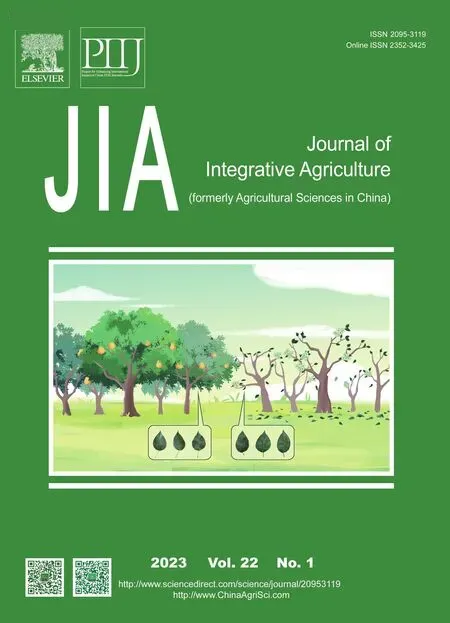 Journal of Integrative Agriculture2023年1期
Journal of Integrative Agriculture2023年1期
- Journal of Integrative Agriculture的其它文章
- Less hairy leaf 1,an RNaseH-like protein,regulates trichome formation in rice through auxin
- Characterization of a blaCTX-M-3,blaKPC-2 and blaTEM-1B co-producing lncN plasmid in Escherichia coli of chicken origin
- Consumers’ experiences and preferences for plant-based meat food: Evidence from a choice experiment in four cities of China
- Farmers’ precision pesticide technology adoption and its influencing factors: Evidence from apple production areas in China
- Visual learning graph convolution for multi-grained orange quality grading
- lnfluence of two-stage harvesting on the properties of cold-pressed rapeseed (Brassica napus L.) oils
